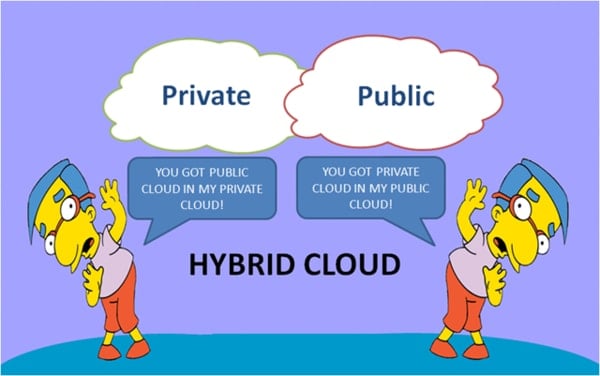
Delta Doesn’t Want to Listen to the Guy Sitting Next to You Either
December 18, 2013
Online Learning Can Take Your Career to the Next Level
December 18, 2013The hybrid cloud is increasingly popular for large businesses. We discuss how enterprises can best leverage both public and private clouds with a hybrid cloud.
Most of the conversation concerning the cloud tends to revolve around cheerleading for one particular implementation model. The focus is on either the benefits or the drawbacks of public and private cloud modalities.
We hear that one or the other is the savior of enterprise IT. But, a more sober analysis reveals that, as with many false dichotomies, the truth lies somewhere in-between.
Small and medium businesses are currently driving the uptake of public cloud platforms, which is leading to a sort of cloud boosterism focused primarily on the public cloud. However, the concerns of large enterprise businesses are not just different in size, they are of a different type, which is why when it comes to such large companies, the hybrid cloud, which combines both modalities, is the way forward.

Why The Private Cloud?
The defining characteristic of the private cloud is that the underlying hardware is dedicated entirely to the use of one organization and is usually incorporated into that company’s own network behind the firewall. We can quibble with some aspects of that definition and the concepts are fuzzy, but in basic terms this is what we mean by the private cloud. The hardware is usually either located in an in-house data center, collocated, or otherwise paid for by one organization.
The private cloud brings many of the usual benefits associated with virtualized infrastructure, including easier deployment of servers and increased utilization of hardware — in theory at least.
Enterprises choose the private cloud because:
- It’s private: — For security and regulatory purposes businesses may need to keep their data close. It can be a leap of faith to entrust business critical information to third parties.
- They can’t abandon legacy systems: — Most large enterprises have been around for many years and have made huge capital investments in both infrastructure and software development. The disruption and cost of abandoning the systems they already have in place would be enormous, and so they build their cloud in-house and layer it on top of their existing legacy systems.
- Cost: — Some businesses have done the math and come to the conclusion that the total cost of ownership of servers and network infrastructure for the private cloud is less expensive than buying compute power, bandwidth, and storage from a public cloud provider. That’s arguable, but dependent on the specific requirements and conditions of each business.
Why The Public Cloud?
Public cloud platforms provide server and networking infrastructure using virtualization or container technology running on hardware that is shared between multiple organizations, or at least, there can be no guarantee that any specific set of infrastructure is used by one company alone. The public cloud abstracts from the underlying hardware and provides an interface for the programmatic deployment of virtual servers and network infrastructure.
The benefits of the public cloud have been well rehearsed, but they include:
- Minimal capital expenditure — Essentially, public cloud platforms move the risk of CAPEX from the client to the vendor. Of course, over time, those costs are going to be passed on to the client, but in the short and medium term, the public cloud requires much less up-front investment.
- On-demand pricing — Rather than paying to provision and manage physical hardware, companies only pay for what they actually use.
- Lower risk of underutilization — Related to both of the above. If companies buy their own hardware they have to ensure that it is used efficiently. The public cloud passes the risk of over investment to the vendors.
- Massively scalable — Public cloud platforms provide scalability that would be extremely expensive to maintain with a private cloud. Public cloud offers scalability in both directions: companies can deploy infrastructure as they need it and discard it when it is no longer useful, which isn’t the case if they have bought or leased physical servers.
Hybrid Cloud: The Best Of Both Worlds?
You’ll have noticed that many of the benefits of public and private cloud are in opposition to each other. Although the public cloud can be just as secure as private, in many cases it’ll be difficult to convince conservative decision makers sufficiently to get them to buy in. Private cloud can involve large up-front investment in both IT management and hardware; the public cloud does not. The public cloud frequently requires a new way of doing things that may not align with previous investment in legacy systems.
There are some security concerns as listed by the IDG Research Services survey, which drew from 145 of the top IT executives on the matter: “More than three-quarters of the respondents cited four specific security-related concerns about hybrid clouds: data loss or leakage, insecure interfaces and APIs, account or service hijacking, and threats arising from unknown risk profiles. By comparison, the highest concern cited about private clouds was “malicious insiders,” and just 63% of the respondents said they were very or somewhat concerned about that possibility.”
But, in each case those benefits are very real and leveraging them is in the interest of most large companies. Obviously, a hybrid cloud environment is the solution and offers:
- Public/Private Compartmentalization — Businesses can leverage the benefits of the public cloud while keeping core data behind the company firewall.
- Cloud Bursting — Businesses can take advantage of the low-cost scalability provided by the public cloud when they need it, while keeping essential processes in-house on a private cloud.
- Proactive disaster avoidance — However resilient one may build a private cloud to be, most businesses do not have the resources to create multiply redundant failover systems on the scale of a public cloud provider. In the event of a catastrophe that takes out a company’s private cloud, they can rely on redundant cloud infrastructure to maintain business continuity.
- Outsourcing of development and test environments — For many use cases, it simply doesn’t make sense to deploy physical hardware when resources can be inexpensively provisioned from a third party.
The question should no longer be: “Should we choose public or private cloud deployment?” Cloud technology has matured to the point where businesses should be taking advantage of the hybrid cloud and determining whether to use public or private based on their specific needs, leveraging the best of each to create a hybrid system that satisfies all use cases.
About the author: This guest blog was by Brett Haines of cloud hosting provider Atlantic.Net. Brett Haines is the Director of Operations at Atlantic.Net with a focus on Facilities, Customer Support, and supporting Research and Development.

